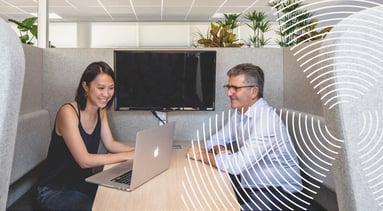Workplace Mental Fitness Volume 1: Rethinking Workplace Design for Employees with ADHD | Q&As with Abi Roni Mattom and Jianhan Qiu

Mental health and well-being are essential to attracting and retaining top talent. As a global leader in workplace strategy, design, and delivery, Unispace helps clients create personalized work environments that support both productivity and well-being.
One growing challenge in today’s workplace is Attention-Deficit/Hyperactivity Disorder (ADHD). In an era of digital distractions and constant connectivity, maintaining focus has become increasingly difficult—especially for Gen Z professionals. Traditional office designs often fall short in supporting individuals with ADHD, yet small, thoughtful design changes can have a profound impact. Let’s explore how workplaces can be designed to foster focus, inclusivity, and productivity for everyone.
 Common area of an international legal firm with natural light to improve mood, reduce stress, and enhance focus
Common area of an international legal firm with natural light to improve mood, reduce stress, and enhance focus
Understanding ADHD in the Workplace
ADHD, or Attention-Deficit/Hyperactivity Disorder, is a neurodevelopmental condition that affects focus, impulse control, and executive functioning. According to the American Psychiatric Association (APA), common symptoms include difficulty sustaining attention, frequent distractions, restlessness, impulsivity, and challenges with organization and time management. In a workplace setting, this can translate into struggles with meeting deadlines, managing workloads, and maintaining focus in open-plan offices. However, individuals with ADHD also bring strengths such as creativity, problem-solving abilities, and hyperfocus in the right environment. By designing workspaces that support different work styles, organizations can help employees with ADHD thrive.
Q&As with Our Experts
To deepen our understanding of ADHD-friendly workplace design, we sat down with some of our experts to answer key questions on how thoughtful design can support focus, well-being, and productivity. Here’s what they had to say:
Interview with Abi Roni Mattom, Country Director, Unispace India

Q1. In your recent book, Future of Workplace Design: Placemaking for a GenBlend Workforce, you discuss the importance of flexible workspaces. How can these spaces be tailored to meet the unique needs of employees with ADHD?
Great question! In the book, I emphasize that flexibility is key in designing workspaces that accommodate diverse needs—including neurodiversity. Carefully designed spaces can support employees with ADHD by balancing structure and adaptability to enhance focus and productivity. Design strategies include quiet zones for deep work, collaborative areas for interactive tasks, and movement-friendly spaces like standing desks or lounge areas. Sensory-friendly features such as adjustable lighting, noise control, and minimal clutter help reduce distractions, while digital tools for task management support organization. By creating inclusive, choice-driven environments, workplaces can empower neurodiverse employees to thrive.
 Themed meeting rooms at VaynerMedia in Singapore allow employees to choose an environment that best suits their mood and sensory preferences, enhancing focus and productivity
Themed meeting rooms at VaynerMedia in Singapore allow employees to choose an environment that best suits their mood and sensory preferences, enhancing focus and productivity
Q2. What specific design elements have you found most effective in minimizing distractions and enhancing focus for neurodiverse employees, particularly those with ADHD?
There are many design elements that help minimize distractions and enhance focus for neurodiverse employees, particularly those with ADHD. Quiet zones with acoustic insulation provide spaces for deep work, while adjustable lighting and natural elements help regulate sensory input. Think of a library space tucked away in the corner, with dimmable lighting, temperature controls, and absolute quiet. Now, imagine if there were an easy way to time it or book it—someone with ADHD-related symptoms would find peace there. Decluttered, organized layouts with clear wayfinding reduce cognitive overload, while movement-friendly setups like standing desks and flexible seating support focus and energy levels. Additionally, integrating digital productivity tools and visual task management systems can aid organization and time management, creating a workspace that fosters both comfort and efficiency.
 A green wall at HP in Gurgaon helps lower stress hormones, creating a calm atmosphere and helping employees feel relaxed
A green wall at HP in Gurgaon helps lower stress hormones, creating a calm atmosphere and helping employees feel relaxed
Q3. How can workplace design integrate digital tools to support employees with ADHD in managing their tasks and time more effectively?
Digital tools are transforming the workplace for everyone. Tech-driven solutions are essential for productivity, whether they have ADHD or not. AI-powered calendars and task management apps aid organization and reminders, while voice-to-text features and focus timers significantly enhance concentration. Interactive whiteboards and project management platforms enable seamless collaboration, and microclimate control systems, personalized via mobile apps, help create an optimal work environment. By blending technology with workspace design, organizations can leverage tech fluency to foster focus, efficiency, and overall well-being—including better support for individuals managing ADHD-related challenges.
 Interactive digital wall at HSBC in Singapore, allowing employees and clients to customize the display through an app based on their sensory needs, creating a calm and fulfilling working environment
Interactive digital wall at HSBC in Singapore, allowing employees and clients to customize the display through an app based on their sensory needs, creating a calm and fulfilling working environment
Q4. How can organizations foster a culture of inclusivity that not only accommodates but also empowers employees with ADHD to leverage their strengths within the workplace?
We can foster a culture of inclusivity and empowerment for employees with ADHD by embracing flexibility, strong support systems, and workplace design that accommodates diverse needs. In Future of Workplace Design, I highlight the importance of adaptive work environments, including quiet zones for deep focus, movement-friendly spaces, and tech-driven tools that aid task management. Beyond physical design, organizations should implement neurodiversity training, promote open communication, and establish mentorship programs that help employees leverage their strengths. Encouraging strength-based roles—where individuals can focus on creativity, problem-solving, or innovation—ensures they thrive rather than struggle with traditional expectations. By normalizing different work styles and offering personalized support, organizations can create an environment where neurodiverse employees feel valued, engaged, and empowered to perform at their best.
 Private phone booth at AlphaSights in Hong Kong, offering a quiet, distraction-free space for focused calls and conversations
Private phone booth at AlphaSights in Hong Kong, offering a quiet, distraction-free space for focused calls and conversations
Interview with Jianhan Qiu, Principal, Strategy, Unispace Southeast Asia

Q1. In your upcoming article in CoreNet Global, you highlight Gen Z’s strong emphasis on well-being at work. How can workplace design specifically address the challenges that Gen Z employees with ADHD face in maintaining focus and mental well-being?
Gen Z has grown up with highly personalized, content-driven platforms like TikTok, where experiences are tailored to individual preferences. This theme naturally extends to workplace design, where a variety of spaces should be available to accommodate neurodivergent employees. Spaces like quiet zones and library corners—designed with muted colors, privacy, and low foot traffic—can help improve focus and create an environment where neurodivergent employees can thrive.
 Quiet zone at ANSR in Bangalore, featuring a peaceful library space for focused work and reading
Quiet zone at ANSR in Bangalore, featuring a peaceful library space for focused work and reading
Q2. Your research shows that a significant portion of Gen Z struggles to stay active during the workday. What role does movement-friendly workplace design play in supporting neurodiverse employees, including those with ADHD?
Movement helps with focus, especially for employees with ADHD. From a design standpoint, workplaces should incorporate indoor walking paths and strategically place “destinations”—such as the IT helpdesk on a less populated floor, the main pantry away from work zones, and wellness areas in quieter corners—to encourage natural movement. From a furniture perspective, adjustable desks and alternative seating options like perch stools can further support neurodivergent employees by allowing flexibility in how they work and reset throughout the day.
 Pantry at Redhill in Singapore, located away from workstations to offer employees a social space to recharge and take breaks
Pantry at Redhill in Singapore, located away from workstations to offer employees a social space to recharge and take breaks
Q3. Technology-enabled personalization is a key trend in future workplaces. How can smart office tools and AI-driven solutions be leveraged to create ADHD-friendly environments that enhance productivity and engagement?
As employee well-being becomes a priority, I foresee more companies investing in AI and smart office tools. Adjustable lighting and noise-masking systems allow employees with ADHD to manage distractions and better focus. Workplace analytics tools like Viva Insights in Outlook can further support time management by analyzing work patterns to reduce burnout—suggesting focus times and scheduling break reminders (give it a go!).
 Warm lighting and noise-masking booths at Takeda in Vietnam help employees manage distractions and maintain better focus, supporting a more productive work environment
Warm lighting and noise-masking booths at Takeda in Vietnam help employees manage distractions and maintain better focus, supporting a more productive work environment
Rethinking Workplace Design for a Neurodiverse Future
As the workforce evolves, so must our approach to workplace design. By integrating flexible work zones, minimizing sensory overload, encouraging movement, and leveraging technology, organizations can create environments that empower employees with ADHD—and all neurodiverse individuals—to thrive.


